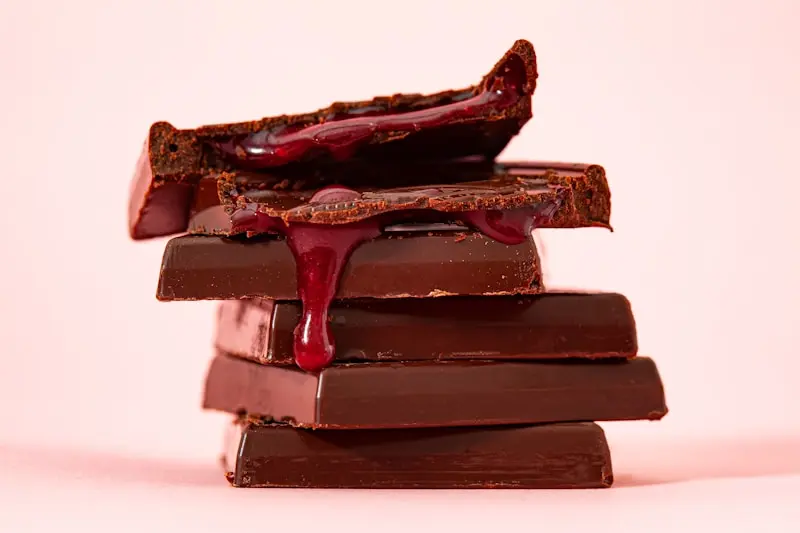
When it comes to making chocolate desserts or baked goods, you can choose between cocoa powder or chocolate bars. While working with cocoa powder is straightforward, melting chocolate bars can be quite tricky. Pastry chefs will tell you that chocolate is a finicky ingredient that can behave unpredictably when melted—it can burn, seize up, or turn into a sticky mess. So, how can you avoid these pitfalls?
If you’re planning to make a cream, filling, or chocolate glaze, the first step is to melt the chocolate. Although this may seem like a simple task, the results don’t always meet expectations. The main challenge is selecting the right chocolate. The ideal choice is professional-grade chocolate, which is often sold in drops, but you can typically find it only in specialty stores. Fondue chocolate is another good option, available at shops that sell fondue equipment. If neither of these is accessible, regular chocolate bars will do, as long as they are completely natural and dark. Avoid chocolate with additives, as it will melt into a sticky lump, and steer clear of milk chocolate, which doesn’t melt well at all.
When melting chocolate, remember that it doesn’t like high temperatures or moisture. It’s best to melt chocolate in a microwave or using a double boiler. Be careful not to overheat the chocolate and ensure that no water droplets get into the bowl.
If you melt the chocolate correctly, you can create a variety of delicious treats. Pour it into any mold, let it cool at room temperature, and then transfer it to the refrigerator to set into shaped candies. You can mix in fresh berries, nuts, or fruits for delightful filled chocolates. Using a piping bag, you can create any decoration for a festive dessert. It also makes a fantastic glaze for cakes. Adding a bit of olive oil will give the glaze a shiny finish; incorporating alcohol or spices can add a sophisticated aroma or refresh the dessert’s flavor. Just remember that melted chocolate sets quickly, so you need to work efficiently.
To make a classic chocolate cream combine 150g of chocolate with 150ml of boiling cream, wait for the chocolate to melt, then stir in one egg yolk and a small piece of butter. You can then add any flavoring that suits your dessert, such as rum, cognac, liqueur, mint, jasmine, lemon zest, or lemon juice. Mix well and let it cool in a cool place overnight. This cream can be used for cake layers and éclairs, or piped into various shapes. If you melt the cream over a double boiler, you’ll have a glaze.
There’s another recipe for chocolate glaze that uses gelatin. Combine 1.5 cups of water, 2 cups of sugar, and 250ml of heavy cream, and bring to a boil. Then add 5 tablespoons of cocoa powder and mix thoroughly. After that, cool the mixture to a warm temperature and stir in 12g of melted gelatin.
In addition to cream and glaze, chocolate is widely used in making cakes and puddings. Here’s a recipe for chocolate in molds. Boil a cup of milk with 1 tablespoon of cocoa, remove from heat, add a cup of sugar and 70g of chopped chocolate. Stir until the chocolate is completely dissolved, then let it cool. Next, add 5 egg yolks, 2 whole eggs, and vanilla, and strain the mixture. Pour it into molds, which should be placed in a baking tray filled with water. Cover the tray and bake until slightly set at 150°C (about 300°F). Serve the chocolate directly in the molds, garnished with whipped cream.
As for cocoa powder, it can be added to any white cream to create a dark filling. Baking is also easier with cocoa powder; in this case, add it at the very end of mixing the batter. If you want to bake a cake that’s nearly black, you don’t need to use a lot of cocoa. Instead, mix a couple of tablespoons of cocoa with 1 tablespoon of olive oil; the fat helps enhance the powder’s color.
You can also make simple hedgehog candies with a filling. Toast various nuts, chop them, and mix with butter or sweetened condensed milk. Then grate chocolate and roll the balls of the nut mixture in it. If you prefer smooth candies, place the nut mixture on a rack and drizzle with glaze.
Finally, here’s a recipe for a chocolate cake with brandy and prunes. Soak 200g of dried fruits for 2 hours, adding 4 tablespoons of brandy. Then chop 75g of chocolate, add 25g of cocoa powder and 2/3 cup of sugar, pour in 150ml of boiling water, and mix until smooth. Whip 4 egg whites and mix them with 1/3 cup of sugar and 75g of flour. Fold the egg whites into the chocolate mixture to create a liquid batter. Pour it into a parchment-lined pan, sprinkle with prunes, and bake for about half an hour at 190°C (about 375°F). Let the sponge cool in the pan, then remove it, drizzle with glaze, and top with fresh berries and fruits.
